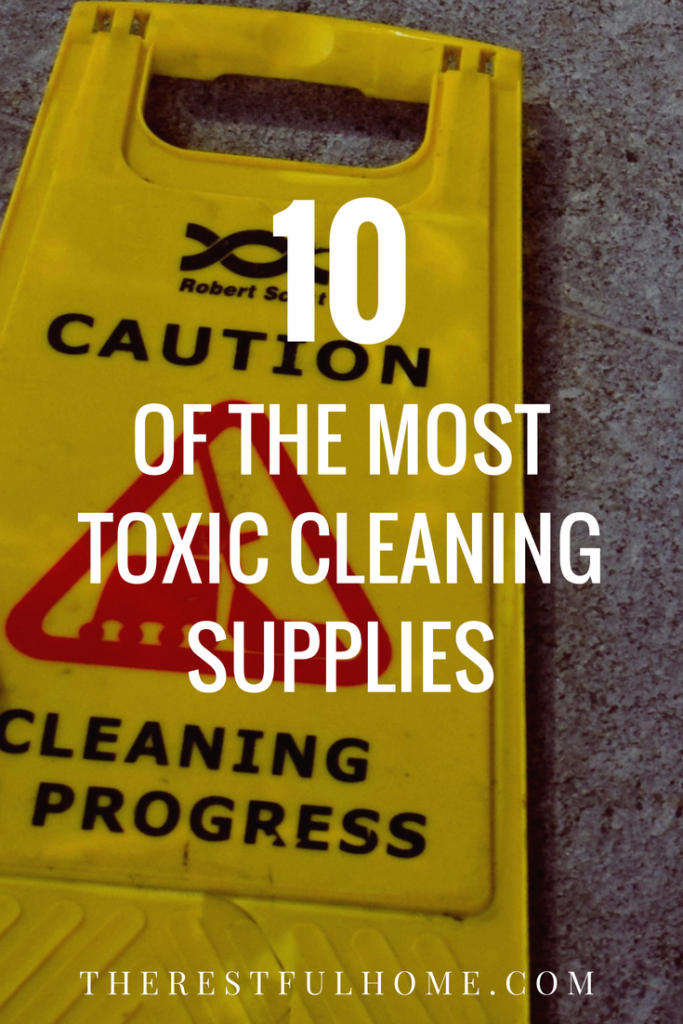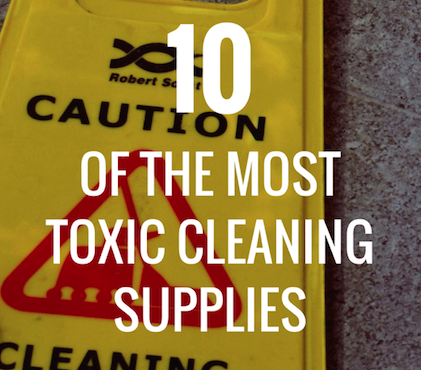
Ten of the Most Toxic Cleaning Supplies
1. Chlorine Discs for Toilet Bowls
First on our list: these chorine TUMS-look-alikes can kill your child (or pet) if he decides to swallow one. In addition, you have to be careful about the cleaners you add to the already-cholorinated mix in your toilet. (Chemical reactions can happen. See the don’t-mix-with-bleach section near the end of this article.)
Additionally, these little toilet pills really aren’t that great for your toilet’s inner parts. For further information, check out this brief article from a plumbing company.
2. Air-Freshening Room Sprays
While air fresheners sound safe because they’re meant to be sprayed in the air, they are actually incredibly risky. A quote from poison.org:
“Despite their popularity, there are concerns that these products increase indoor air pollution and pose a health risk, especially with long-term exposure. Air fresheners release volatile organic compounds (VOCs) into the air. A VOC is a type of chemical that turns into a vapor or gas easily at room temperature. Health problems are thought to occur from the chemicals in the air fresheners and from their secondary pollutants. Secondary pollutants are formed when a product’s chemicals combine with the ozone already in the air. Even when these products are used as directed, there are concerns about health problems with repeated exposure. Unintentional injuries have been reported with these products, including burns when flammable air fresheners have been ignited by a nearly flame.”
Many air fresheners also contain formaldehyde, among other pollutants. (Read this article for a full list.) Though your house might smell good after you spray, it’s safer to just open a window.
3. Scrubbing Bubbles
Yes, we have a can of these fancy foaming (and scary-smelling) bubbles. But after further research, we won’t be buying any more of them. Scrubbing Bubbles contain alkyl dimethyl benzyl ammonium chlorides (potential respiratory issues) and butoxydiglycol (banned in the EU at concentrations over 3 percent due to its negative effects on the human lung).
The ingredients in Scrubbing Bubbles are an effective bacteria-killer. However, they can also be hazardous for your health, so unless you have some major disease-busting to do in your bathroom, use something safer (such as one of these vinegar-based cleaning solutions). You can check out the link to the EWG’s scoring of Scrubbing Bubbles here.
4. Drain Cleaners
Check to see if your drain cleaner contains the poisonous sodium hydroxide. (Yes, Drano contains sodium hydroxide, or lye.) If so, here are possible side effects if you or your child accidentally swallow some, according to Medline.gov:
“Damage to the esophagus and stomach continues to occur for several weeks after the sodium hydroxide was swallowed. Death may occur up to several months later from additional complications. Holes (perforations) in the esophagus and stomach may cause serious infections in the inside spaces of the chest and abdomen, which may lead to death. Surgery may be needed if the chemical has perforated the esophagus, stomach, or intestine.”
Question: So what can you do if your drain is plugged?
First, you may choose to use Drano and other similar products in small quantities. Just keep them far away from your child and out of reach of any children who may visit you.
Second, you might want to consider other fixes. Here’s an article entitled “Why Plumbers Advise Against Drano,” in case you’d like to know what lye does in your pipes.
5. Toilet Bowl Cleaners
Many toilet bowl cleaners are extremely toxic. Here’s a quote from OrganicConsumers.org:
“The most acutely dangerous cleaning products are corrosive drain cleaners, oven cleaners, and acidic toilet bowl cleaners, according to Philip Dickey of the Washington Toxics Coalition. Corrosive chemicals can cause severe burns on eyes, skin and, if ingested, on the throat and esophagus. Ingredients with high acute toxicity include chlorine bleach and ammonia, which produce fumes that are highly irritating to eyes, nose, throat and lungs, and should not be used by people with asthma or lung or heart problems. These two chemicals pose an added threat in that they can react with each other or other chemicals to form lung-damaging gases. Combining products that contain chlorine and ammonia or ammonia and lye (in some oven cleaners) produces chloramine gases, while chlorine combined with acids (commonly used in toilet bowl cleaners) forms toxic chlorine gas.”
Just one example: Lysol Disinfectant Power Toilet Bowl Cleaner With Lime & Rust Remover. Check the label; it’s fatal if swallowed.
6. Comet
Comet. It’s always been one of my all-time favorite household cleaners, because it just works so well with getting rid of scum. But we need to be careful with this corrosive cleaner. The Environmental Working Group did a test on Comet in the mid 2000s, and these were the results of their test:
“This product emitted 146 different chemicals, including some thought to cause cancer, asthma and reproductive disorders. The most toxic chemicals detected – formaldehyde, benzene, chloroform and toluene – are not listed on the label. Little is known about the health risks of most of the contaminants found.”
So, yes, powdery Comet is actually among the most toxic cleaning supplies. And I should rethink my current list of favorite cleaning supplies…
7. Oven Cleaners
Your self-cleaning function on your oven doesn’t work? Pause before you spray on an oven cleaner. Even if the manufacturer advertises it as “fume free”! Oven cleaners contain highly concentrated lye, which can be very dangerous to humans.
“It does not matter if it’s sold as no fume oven cleaner or not. They are toxic to humans for a good reason. See, the active ingredient is concentrated lye (caustic alkali, also known as a base). When the stuff is concentrated it is highly corrosive to organic materials. Guess what persistent food deposits in your oven are. Precisely, a success oven cleaner should be able to dissolve them. Unfortunately humans are also entirely organic material. This is why it is of utmost importance to use protective gear when using the nasty chemicals. Oven cleaner poisoning is very common although fatal cases are a rarity.” (Source: “Truths and Myths of Oven Cleaner Fumes.”)
So, use with care! (Alternatively, use baking soda and lemon juice and/or high heat. See the Kid-Safe Cleaning Solutions article for ideas. It’s not necessary to use toxic cleaning supplies to take good care of your home!)
8. Dishwasher Detergents
Keep your dishwasher detergents locked away from small children. Swallowing them can cause severe problems, including major abdominal pain, bloody vomiting and stool, burns inside one’s esophagus, etc. (Read Medline’s article to read more symptoms and find out what to do if one of your family members has swallowed dishwasher detergent.) Yes, dishwashers make your life easier. But maybe getting the dishwasher ready to go is a job for the adults in the house.
9. Bleach
While bleach is sometimes necessary for removing mold and mildew, it’s one of the most toxic cleaning supplies readily available. Chlorine-based bleaches are common. Here’s what the CDC says about chlorine gas: “When chlorine gas comes into contact with moist tissues such as the eyes, throat, and lungs, an acid is produced that can damage these tissues.” There can also be long-term repercussions of regularly using bleach:
“Long-term complications may occur after breathing in high concentrations of chlorine. People…[may] develop severe health problems such as fluid in the lungs (pulmonary edema) following the initial exposure.”
Additionally, since bleach reacts with other products, make sure you never add products containing these ingredients to a toilet bowl full of bleach: ammonia, acids (such as vinegar), or even “dirty” water.
Question: If you don’t use bleach, what do you use for mold? Or mildew?
Try vinegar, which will help with most cases. Just mix it with water.
10. Ammonia
Ammonia is a powerful and often effective component of many household cleaners. It’s also one of the MOST toxic cleaning supplies! So make sure you don’t take a deep breath of ammonia-laden air while using it as a cleaner. Here’s a quote from New York State’s health department:
“Ammonia is corrosive. The severity of health effects depends on the route of exposure, the dose and the duration of exposure. Exposure to high concentrations of ammonia in air causes immediate burning of the eyes, nose, throat and respiratory tract and can result in blindness, lung damage or death. Inhalation of lower concentrations can cause coughing, and nose and throat irritation.
Swallowing ammonia can cause burns to the mouth, throat and stomach. Skin or eye contact with concentrated ammonia can also cause irritation and burns.”
Be Careful!
Photo by Oliver Hale.
In conclusion, know your products and what they are capable of doing if your children or pets find an open bottle lying around. Find out what to do if the worst happens. (Hint: rinsing with water usually helps! And call Poison Control!) Be careful!
One last quote from Organic Consumers: “In 2000, cleaning products were responsible for nearly 10% of all toxic exposures reported to U.S. Poison Control Centers, accounting for 206,636 calls. Of these, 120,434 exposures involved children under six, who can swallow or spill cleaners stored or left open inside the home.”
Usually, it’s just safer to use vinegar and/or baking soda. And, if the smell bothers you, add a few drops of an essential oil. (But make sure you keep those locked up, as well!) Open a window. Walk out of the room for a few seconds.
You may also enjoy reading our article with 10 recipes for Kid-Safe Cleaning Solutions.
Recommended additional reading on toxic cleaning supplies: “Safe Spring Cleaning,” published by Poison Control.

